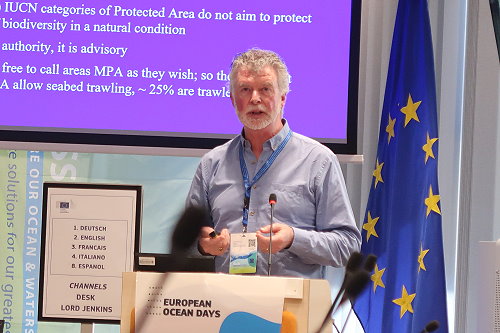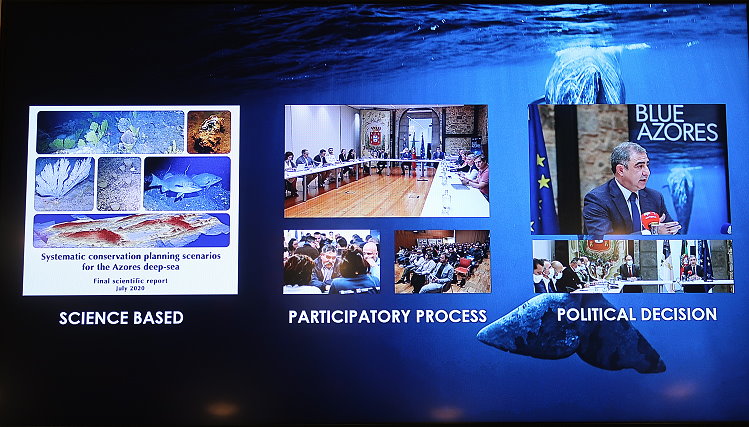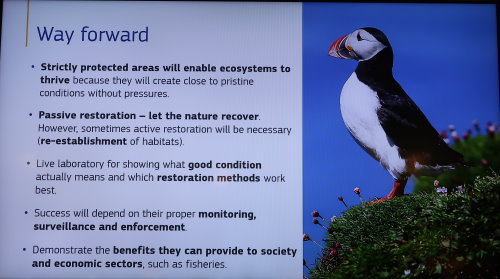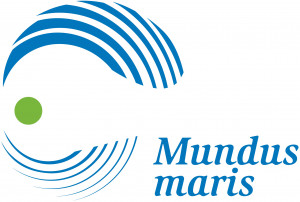The 4th EU Blue Parks Community Workshop took place on 6 March 2025 in Brussels as part of the third edition of the EU Ocean Days for the Mission ‘Restore our Ocean and Rivers by 2030’. Speakers explored the transition to 10% strict protection as part of the mandate to protect 30% of the waters by 2030, emphasizing evidence-based benefits for biodiversity and ecosystems, fisheries and coastal communities. The workshop was intended to offer actionable insights into how strict protection can strengthen conservation while supporting well-being and sustainable livelihoods.
 Strict protection has proven highly effective in restoring marine ecosystems, leading to significant increases in species biomass and overall ecological resilience as Mark Costello underlined in his review of the published evidence.
Strict protection has proven highly effective in restoring marine ecosystems, leading to significant increases in species biomass and overall ecological resilience as Mark Costello underlined in his review of the published evidence.
Managers of nominally protected areas e.g. from Italy, reported that enforcement remained challenging and could not always be ensure. Thus, despite the overwhelming evidence of its benefits, the EU remains far from achieving its 10% strict protection target.
Currently, only 0.03% of EU seas are strictly protected, and political reluctance, governance challenges, and stakeholder concerns continue to slow progress.
The concept of strict protection is now more widely understood across countries, but when it comes to its practical implementation doubts and excuses linger. During the meeting it became evident as well that without stronger political will and broader stakeholder buy-in, scaling up strict protection will remain elusive. Scientific evidence alone is not enough to drive action. Unless the socio-economic benefits accrue to those making the greatest ‘sacrifices’ during the transition period when they must change their business model or at least some practices, they will not make them. Moreover, sustained engagement with affected sectors and explicit demands from a broader public are critical.

The Azores stands out as a notable example of how political ambition, stakeholder inclusion, and financial investment can expand marine protection. By increasing its MPA network from 15% to 30%, the region now hosts Europe’s largest network of protected marine areas. This expansion was accompanied by a structured fisheries restructuring plan, backed by a €10 million fund over five years to mitigate socio-economic impacts.
 Stakeholder and wider citizen engagement was mooted as a key success factor by most speakers, but how to turn this into practices in all European seas is not as clear as the recognition of the principle. It requires sustained trust building processes as underlined by Sylvain Blouet of the Marine Protected Area (MPA) Côte Aganthoise in France. Not all MPAs have the human and financial resources and the mindset for patient and inclusive dialogue based processes to reach tangible results. To achieve the 10% goal of strictly protected areas within 30% perhaps somewhat lightlier protected MPAs remains a tough target requiring steep progress in implementation, especially if you put that into a context of the remaining 70% of the sea being also responsibly managed for good environmental status. Just moving all currently unsustainable activities outside of MPAs does not cut it. More serious transformations are needed for society and nature to reap the full benefits.
Stakeholder and wider citizen engagement was mooted as a key success factor by most speakers, but how to turn this into practices in all European seas is not as clear as the recognition of the principle. It requires sustained trust building processes as underlined by Sylvain Blouet of the Marine Protected Area (MPA) Côte Aganthoise in France. Not all MPAs have the human and financial resources and the mindset for patient and inclusive dialogue based processes to reach tangible results. To achieve the 10% goal of strictly protected areas within 30% perhaps somewhat lightlier protected MPAs remains a tough target requiring steep progress in implementation, especially if you put that into a context of the remaining 70% of the sea being also responsibly managed for good environmental status. Just moving all currently unsustainable activities outside of MPAs does not cut it. More serious transformations are needed for society and nature to reap the full benefits.
The summary report of the workshop is available here. You can learn more about the Blue Parks Community and join here.
